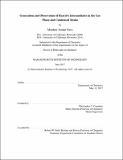Generation and observation of reactive intermediates in the gas phase and condensed media
Author(s)
Nava, Matthew Jordan
DownloadFull printable version (67.28Mb)
Other Contributors
Massachusetts Institute of Technology. Department of Chemistry.
Advisor
Christopher C. Cummins.
Terms of use
Metadata
Show full item recordAbstract
A molecular beam mass spectrometer (MBMS) has been constructed and upgraded with a laser desorption system. MBMS has allowed for the detection of reactive small molecules including but not limited to P₂ from P₂A₂ (where A = anthracene, C₁₄H₁₀), HCP from PPh₃(HCP)A and various dialkylamino phosphinidenes from their corresponding dibenzo-7-phosphanorbornadiene precursors by mass spectrometry. In cases where the desired reactive small molecule was not detected, MBMS has provided valuable information as to the degradation processes which may be occurring and has guided molecular precursor development. Through the use of highly sensitive microwave spectroscopic techniques, it was found that H₂S and N₂O₃ react to form the elusive molecule HSNO in the gas phase. HSNO is believed to be a crucial intermediate in biological signaling. Through isotopic labeling studies, an accurate structure of HSNO could be derived and subsequent degradation of the molecule was explored. The hexacarboxamide cryptand mBDCA-5t-H₆ was used as a ligand to prepare mono- and bimetallic iron complexes of the formula [Fe₂(mBDCA-5t)]²- and [Fe(mBDCA-5t-H³)]-. Both complexes were observed to react reversibly or irreversibly with CO or NO respectively to afford [(FeEO)-Fe(mBDCA-5t)]²- or [FeEO(mBDCA-5t-H₃)]- where E = C or N. Treatment of [(FeNO)·Fe(mBDCA-5t)]2- with excess NO resulted in the formation of [Fe₂O(mBDCA-5t)]²-, which could be independently prepared by treatment of [Fe₂(mBDCA-5t)]²- with the O-atom transfer reagent N-methylmorpholine N-oxide. The chemistry of peroxide dianion, in the form of the encapsulated complex [O₂[subset]mBDCA- 5t-H₆]²-, has been explored in nonaqueous media. In particular, [O₂[subset]mBDCA-5t-H₆]²- was demonstrated to react with CO gas at 40 °C over the course of several hours to furnish the encapsulated carbonate cryptate, [CO₃[subset]mBDCA-5t-H₆]²-. Through labeling studies, it was confirmed that the carbon of the carbonate was derived from CO. Treatment of [O₂[subset]mBDCA-5t-H₆]²- with CO₂ also affords [CO₃[subset]mBDCA-5t-H₆]²-, but with concomitant oxidation of the solvent. The oxidation of the solvent was found to proceed through the reactive oxidants -O₂COOCO²- and HOOCO₂- and sheds light on oxidative processes which may be occurring in lithium-air cells. Exposure of solid Li₂O₂ to gaseous p-benzoquinone results in the formation of a blue coating on Li₂O₂. This coating was identified as the quinone radical anion Li[p-C₆H₄O₂], which forms via lithium and electron transfer from Li₂O₂. This charge and ion transfer process results in the conversion of Li₂O₂ to LiO₂, a long-sought intermediate in the lithium-air community.
Description
Thesis: Ph. D., Massachusetts Institute of Technology, Department of Chemistry, 2017. This electronic version was submitted by the student author. The certified thesis is available in the Institute Archives and Special Collections. Cataloged from student-submitted PDF version of thesis. Includes bibliographical references.
Date issued
2017Department
Massachusetts Institute of Technology. Department of ChemistryPublisher
Massachusetts Institute of Technology
Keywords
Chemistry.